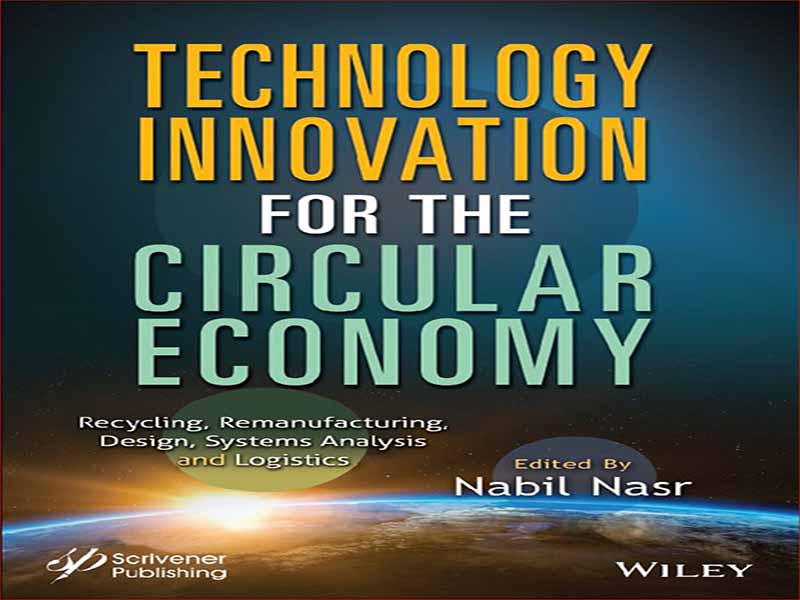- عنوان مجله: Technology Innovation for the Circular Economy
- نویسنده: Nabil Nasr
- حوزه: َاقتصاد دایره ای
- سال انتشار: 2023
- تعداد صفحه: 1215
- زبان اصلی: انگلیسی
- نوع فایل: pdf
- حجم فایل: 28.3 مگابایت
اجماعی که ما به اقتصاد دایره ای نیاز داریم در حال افزایش است. تصمیم گیرندگان در دولت و صنعت به طور فزاینده ای ارزش فوری را می بینند که چرخش می تواند برای بخش تولید به ارمغان بیاورد، در حالی که به برخی از بزرگترین چالش های جهانی امروزی رسیدگی می کند. در عین حال، تحقیقات آکادمیک به بررسی سوالات سخت فنی و لجستیکی که برای تحقق یک اقتصاد دایره ای نیاز به پاسخ دارند، ادامه می دهد. در موسسه REMADE، من و همکارانم میخواستیم با گرد هم آوردن بهترین تحقیقات و نوآوریها که به دنبال حل چالشهای پیادهسازی اقتصاد دایرهای هستند، این انرژی جمعآوری را جذب کنیم. نتیجه اولین اجلاس و کنفرانس فناوری اقتصاد دایره ای REMADE بود که در مارس 2023 در ساختمان آکادمی ملی علوم در واشنگتن دی سی برگزار شد و بیش از 300 شرکت کننده را جذب کرد، کنفرانس تحقیقات علمی، مدل های کسب و کار و تدارکات با نزدیک به 60 ارائه ارائه شد. تحقیقات اصلی، و همچنین سخنرانیهای کلیدی و جلسات عمومی از رهبران فکری رویایی. این کنفرانس با مشارکت بنیاد الن مک آرتور، یکی از مؤثرترین حامیان اقتصاد دایره ای در حال کار امروز، و با حمایت وزارت انرژی ایالات متحده (DOE) برگزار شد. کتاب زیر مقالات بررسی شده را که در طول کنفرانس ارائه شده است گردآوری می کند. این مواد حوزههای عمیق طراحی اقتصاد دایرهای، برنامهریزی، مدلهای تجاری و فناوریهای توانمند را پوشش میدهند. مؤسسه REMADE یک مؤسسه ملی با مشارکت عمومی و خصوصی است که بر تسریع اجرای اقتصاد دایره ای در ایالات متحده تمرکز دارد. REMADE یکی از شش مؤسسه تولیدی ایالات متحده است که تحت عنوان مواد پیشرفته و فناوریهای تولیدی DOE (AMMTO) فعالیت میکند. REMADE کنسرسیومی متشکل از 170 عضو (90 صنعت، 42 دانشگاه، 32 انجمن تجاری و شش آزمایشگاه ملی) است. این شکافهای دانش را بررسی میکند که پس از غلبه بر آنها، میتواند منجر به پذیرش سریعتر شیوههای اقتصاد دایرهای شود. کنفرانس 2023 شامل اعضای REMADE و همچنین غیرعضو بود و شامل محققان بین المللی از بسیاری از کشورها از جمله ژاپن، آلمان، فرانسه، بریتانیا و ایرلند بود. اول، مهم است که بدانیم چرا اقتصاد دایره ای در دهه گذشته توجه زیادی را به خود جلب کرده است و چه نقشی می تواند در کاهش ردپای زیست محیطی توسعه صنعتی ایفا کند. آینده باید دایره ای باشد و در اقتصاد تولیدی این بدان معناست که رشد اقتصادی بیشتر به استخراج ارزش از مواد موجود بستگی دارد تا تامین منابع جدید مواد اولیه. ساخت مجدد، نوسازی، استفاده مجدد و بازیافت فرآیندهایی هستند که برای رسیدن به این هدف نیاز به پیشرفت و گسترش بیشتری دارند. علاوه بر این، روشهای طراحی ما باید برای اطمینان از موثر و اقتصادی بودن این فرآیندها از طریق طراحی، تکامل یابد. در بسیاری از صنایع، بقای آینده مستلزم توسعه مجدد ساختارهای کسبوکار برای ایجاد مدلهای ذاتی بازسازیکنندهتر است – ایدهای که گروههای آیندهاندیشی مانند بنیاد الن مک آرتور قاطعانه آن را ترویج میکنند. برخی از بزرگترین فرصت ها برای نوآوری در اقتصاد دایره ای در تولید مجدد، نوسازی، استفاده مجدد و بازیافت است. با این حال، برای رشد آن، تحولات در رویکردهای طراحی محصول و مدل کسب و کار تولیدی حیاتی است که اغلب با چالشهایی در اقتصادهای فعلی و عمدتاً خطی زنجیرههای تولید جهانی امروزی مواجه میشوند. فراتر از جنبه های فنی و لجستیکی، این فرآیندها همچنین با موانع بازار و سیاستی روبرو می شوند که رشد آن را در سراسر اقتصاد صنعتی متوقف می کند. برای مبارزه با این چالشها، سرمایهگذاریهای قابل توجه در تحقیقات فناوری، چه دولتی و چه خصوصی، اهمیت و فرصتهای نوآوری را در تعقیب اقتصاد دایرهای انعطافپذیرتر نشان میدهد. این کتاب از 56 فصل در 10 قسمت تشکیل شده است که حوزه های گسترده ای از تحقیقات و کاربردها در حوزه اقتصاد دایره ای را پوشش می دهد. چهار بخش اول، کار سطح سیستم مربوط به رویکردهای اقتصاد دایره ای، مدل ها و پیشرفت ها از جمله استفاده از هوش مصنوعی (AI) و یادگیری ماشینی برای هدایت پیاده سازی و همچنین طراحی برای رویکردهای دایره ای را بررسی می کند. فنآوریهای بازیافت مکانیکی و شیمیایی به دنبال آن هستند که برخی از پیشرفتهترین تحقیقات در این زمینهها را برجسته میکنند. در مرحله بعد، نوآوری در تولید مجدد با توصیف برخی از پیشرفته ترین کارها در این زمینه پرداخته می شود. این امر با تولید مجدد و بازیافت لاستیک دنبال می شود و فناوری های نوآورانه را در رسیدگی به حجم تایرهای پایان مصرف برجسته می کند. مسیرهایی برای انتشار خالص صفر در تولید مواد، این کتاب را با تمرکز بر کربن زدایی صنعتی به پایان می رساند.
The consensus that we need a circular economy is gaining speed. Decision-makers in government and industry increasingly see the immediate value that circularity can bring to the manufacturing sector, while addressing some of today’s greatest global challenges. At the same time, academic research continues to investigate the tough technological and logistical questions that need to be answered for a circular economy to become reality. At the REMADE Institute, my colleagues and I wanted to capture this gathering energy by bringing together the best research and innovation looking to solve circular economy implementations challenges. The result was the _irst-ever REMADE Circular Economy Tech Summit and Conference, which took place in March 2023 at the National Academy of Sciences building in Washington, D.C. Attracting over 300 attendees, the scienti_ic research, business models and logistics conference featured nearly 60 presentations of original research, as well as keynotes and plenaries from visionary thought leaders. The conference was held in partnership with the Ellen MacArthur Foundation, one of the most in_luential advocates for a circular economy at work today, and supported by the U.S. Department of Energy (DOE). The following book compiles the peer-reviewed papers that were presented over the course of the conference. These materials cover indepth areas of circular economy design, planning, business models, and enabling technologies. The REMADE Institute is a public-private partnership, national institute, that focuses on the acceleration of circular economy implementations in the United States. REMADE is one of six U.S. manufacturing institutes that operate under the DOE’s Advanced Materials and Manufacturing Technologies Of_ice (AMMTO). REMADE is a consortium of 170 members (90 industry, 42 universities, 32 trade associations, and six national labs). It addresses knowledge gaps that, once overcome, can lead to faster adoption of circular economy practices. The 2023 conference included REMADE members, as well as non-members, and included international researchers from many countries including Japan, Germany, France, UK, and Ireland. First, it is important to understand why circular economy has gained so much attention over the last decade and what role it can play in reducing the environmental footprint of industrial development. The future should be circular, and in the manufacturing economy this means that economic growth will come to depend more on extracting value from existing materials than securing new virgin material supplies. Remanufacturing, refurbishment, reuse, and recycling are processes that need more advancement and expansion to achieve this goal. In addition, our design methods have to evolve to ensure that these processes are effective and economical through design. In many industries, future survival will require transformative redevelopment of business structures to create more inherently regenerative models — an idea that forward-thinking groups like the Ellen MacArthur Foundation are adamantly promoting. Some of the greatest opportunities for innovation in the circular economy are in remanufacturing, refurbishment, reuse, and recycling. Critical to its growth, however, are developments in product design approaches and the manufacturing business model that are often met with challenges in the current, largely linear economies of today’s global manufacturing chains. Beyond the technical and logistical, these processes also meet with both market and policy barriers that sti_le its growth across the industrial economy. To combat these challenges, signi_icant investments in technology research, both public and private, highlight the importance of and opportunities for innovation in pursuit of a more resilient, circular economy. This book consists of 56 chapters in 10 parts covering broad areas of research and applications in the circular economy area. The _irst four parts explore the system level work related to circular economy approaches, models and advancements including the use of arti_icial intelligence (AI) and machine learning to guide implementation, as well as design for circularity approaches. Mechanical and chemical recycling technologies follow, highlighting some of the most advanced research in those areas. Next, Innovation in remanufacturing are addressed with descriptions of some of the most advanced work in this _ield. This is followed by tire remanufacturing and recycling, highlighting innovative technologies in addressing the volume of end-of-use tires. Pathways to net-zero emissions in manufacturing of materials concludes the book, with a focus on industrial decarbonization.
این کتاب را میتوانید از لینک زیر بصورت رایگان دانلود کنید:

































نظرات کاربران